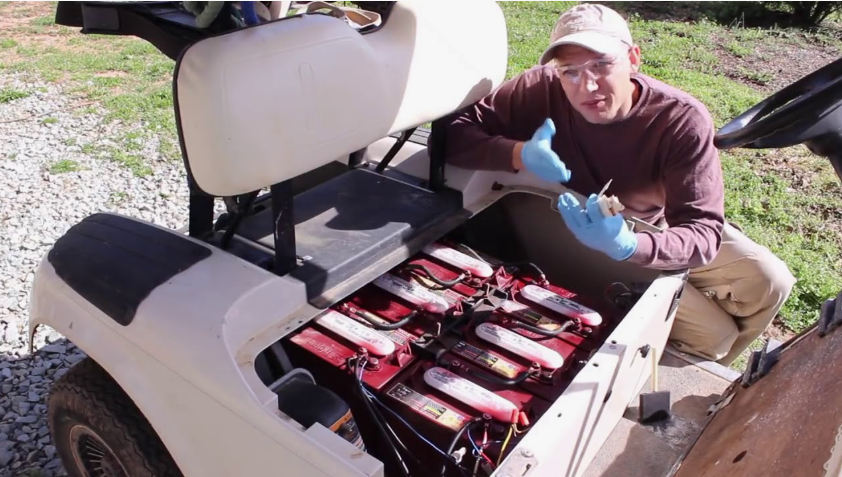When it comes to maintaining the performance and lifespan of your golf cart, one of the most crucial aspects is how you handle your lithium golf cart battery. Known for their long life, fast charging, and consistent power output, lithium batteries have become the preferred choice for golf enthusiasts and course owners alike. However, improper charging or storage can reduce their efficiency and lifespan significantly. This guide will help you understand the right ways to charge and store your lithium battery safely — ensuring that your golf cart stays reliable and ready for the next round.
Table of Contents
ToggleUnderstanding Lithium Golf Cart Batteries
Lithium batteries differ greatly from traditional lead-acid types. They are lighter, charge faster, and provide consistent voltage until fully discharged. They also require less maintenance and can last up to ten years when properly handled. However, because of their advanced chemistry, they demand specific care during charging and storage.
Many people experience problems with lithium batteries in golf carts due to lack of awareness or poor maintenance habits. Common issues include overcharging, exposure to extreme temperatures, or using the wrong charger. Understanding these challenges and following proper charging and storage guidelines can help you avoid costly replacements and ensure your battery performs at its best for years.
1. Use the Right Charger
The most important rule when charging a lithium golf cart battery is to always use a charger designed for lithium-ion technology. Lead-acid chargers deliver different voltage and current patterns that can damage lithium cells over time.
A lithium-specific charger includes smart charging technology that automatically stops charging once the battery reaches full capacity. This prevents overcharging, which can lead to overheating or capacity loss. Always double-check the voltage compatibility before plugging in your charger.
2. Charge in a Cool, Dry Environment
Temperature plays a critical role in battery health. Lithium batteries perform best when charged at moderate temperatures, ideally between 10°C and 30°C (50°F to 86°F). Charging in extremely hot or cold conditions can stress the battery’s internal components, causing permanent damage.
Avoid charging your golf cart outdoors under direct sunlight or in freezing conditions. Instead, choose a well-ventilated and shaded area to maintain a stable temperature during the charging process.
3. Avoid Deep Discharges
Unlike lead-acid batteries that benefit from full discharge cycles, lithium batteries should not be completely drained. It’s best to recharge your battery when it reaches about 20–30% capacity.
Allowing a lithium battery to drop to 0% can reduce its overall lifespan and make it difficult to recharge later. Frequent partial charges are much healthier for lithium cells and help maintain consistent performance.
4. Monitor the Battery Regularly
Modern lithium batteries come with a built-in Battery Management System (BMS) that monitors voltage, temperature, and charging status. Regularly checking this data helps you ensure everything is running smoothly.
If your golf cart doesn’t have a digital display, consider using a separate battery monitor or app. Early detection of irregular voltage drops or overheating allows you to address issues before they become serious.
5. Proper Storage Techniques
If you’re not planning to use your golf cart for an extended period — for example, during the off-season — proper storage is essential. Always store the battery in a cool, dry place away from direct sunlight or moisture.
Make sure the battery is charged to around 50–60% before storing. Storing a fully charged or completely discharged battery for months can degrade its cells. During long storage periods, check the charge level every few months and recharge slightly if it drops below 40%.
6. Keep Terminals Clean and Secure
Battery terminals should be clean, dry, and tightly connected at all times. Dirt, corrosion, or loose connections can affect charging efficiency and lead to power loss. You can clean terminals with a soft cloth and a small amount of rubbing alcohol.
Avoid using harsh chemicals or metal brushes, as they might damage the terminal coating. Ensuring proper contact between the charger and battery is vital for smooth energy transfer.
7. Protect from Physical Damage
Lithium batteries are sensitive to impact or puncture, which can cause internal short circuits or even fires. Always handle your battery carefully when installing, removing, or transporting it.
Make sure the battery compartment in your golf cart is clean, dry, and properly padded to prevent vibration damage. If your cart operates on rough terrain, consider installing vibration-absorbing mats beneath the battery.
8. Balance the Battery Cells Periodically
Over time, lithium battery cells can become slightly imbalanced, causing uneven charging and reduced efficiency. Some advanced chargers include a balancing function to equalize cell voltage.
If your charger lacks this feature, you can use a dedicated lithium battery balancer every few months. Balanced cells ensure your battery charges fully and evenly, extending its overall life span.
9. Avoid Overcharging and Overnight Charging
Even though modern lithium chargers stop automatically, it’s still good practice to disconnect the charger once the process is complete. Leaving the battery plugged in for days may keep it at a high voltage level unnecessarily, which can gradually degrade cell capacity.
Make a habit of checking your golf cart while charging and unplug it once the charger indicates a full charge. Setting a timer can help prevent overcharging during busy schedules.
10. Safety Precautions and Fire Prevention
While lithium batteries are generally safe, mishandling them can create hazards. Always keep fire extinguishers nearby when working with large-capacity lithium packs. Avoid exposing the battery to flames or sparks and do not attempt to repair a damaged battery yourself.
If you notice swelling, leakage, or excessive heat during charging, immediately stop the process and contact a professional for inspection.
When It’s Time for a Replacement
Even with the best care, every battery eventually reaches the end of its useful life. Signs of wear include slower charging, reduced driving range, or inconsistent power delivery. When replacement becomes necessary, consider exploring compatible alternatives such as a replacement battery for power wheels or other lithium models designed for similar voltage and performance levels. Choosing the right replacement ensures your golf cart continues to operate efficiently without downtime.
Conclusion
Properly charging and storing your lithium golf cart battery can make a significant difference in its performance, safety, and longevity. By following recommended practices — such as using the correct charger, avoiding deep discharges, and storing under ideal conditions — you can protect your investment and enjoy uninterrupted rides for years.
A little care and attention go a long way in maintaining your battery’s health and ensuring your golf cart remains a reliable companion on every fairway.



Leave a Reply